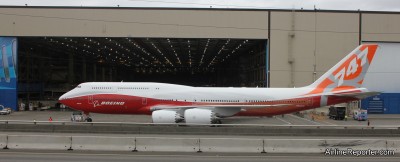
The first Boeing 747-8 Intercontinental caught outside in the natural light after being pulled out of the factory.
Hot damn! That was a big shocker. I was wondering what the livery of the first Boeing 747-8 Intercontinental would look like and I wasn’t guessing orange. I thought maybe the standard livery, the light livery, Lufthansa’s colors, Boeing Business Jet or possibly even Air Force One. I think the choice surprised everyone. Boeing is calling it the “Sunrise Livery.” Kudos to Boeing for being able to keep this cat in the bag for so long.
The event today was quite the scene. Great speakers, music and lighting. Although, the smoke and lights made photography a little tricky.
I have to say the color choice is gorgeous. I don’t think the real beauty comes out in the photos. The paint is metallic, so up close it really sparkles. So why orange right? Directly from Boeing: “The airplane unveiled today is painted in a new Sunrise livery of red-orange that only will appear on the first 747-8 Intercontinental and is a significant departure from Boeing’s standard blue. The new color palette honors many key Boeing customers whose cultures recognize these colors as symbols of prosperity and good luck.” Either way, she is one beautiful airplane and I cannot wait to see her fly.
As of now, the first flight is scheduled for Spring 2011. Since the Boeing 747-8 Freighter has been going through so many different flight tests, the additional tests for the 747-8 Intercontinental won’t be as intensive. This aircraft (N6067E) will be painted in the Sunrise Boeing livery during flight tests. It then will be painted to the customer’s livery before delivery. Of course, there is still no word who the owner of the first aircraft will be. There were representatives from Lufthansa and Korean Air present at the ceremony. Currently Lufthansa has 20 orders for the 747-8I and Korean Air has five.
UPDATE 5:00pm:
Just got to watch as the first 747-8I was pulled out of the factory and parked at the fuel dock. It was very nice seeing it in the natural light and I think these photos better represent what the aircraft looks like in person. During the event people were talking about the livering having red and that was difficult to see. Outside, you could clearly see the red and orange on the body and near-neon orange of the tail. It is one long plane and beautiful plane. Boeing just tweeted one from the ground that looks great and I added seven more photos…
CHECK OUT ALL 29 PHOTOS FROM THE BOEING 747-8 INTERCONTINENTAL UNVEILING AND GOING OUTSIDE!
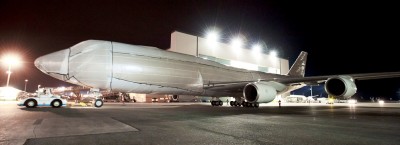
The first Boeing 747-8 Intercontinental comes out of the paint hangar all wrapped up. Won't know the livery until Sunday. Photo by Boeing.
Sneaky Boeing. Last night the first Boeing 747-8 Intercontinental was moved from the paint hangar back to the Boeing factory. I have been trying to find out what livery the aircraft was and was hoping that a keen eye might have caught it out in the open. However, Boeing was smart enough to wrap the 747-8I up like a present. Guess we will have to wait until tomorrow.
This first Boeing 747-8I is a Boeing Business Jet (BBJ) and will be going to a government buyer. Boeing is not saying what government will be taking ownership of the aircraft. Since the plane will most likely have a custom livery done before delivery, the livery on the plane now really could be anyone’s guess.
Remember, Boeing will be doing a live webcast of the event at NewAirplane.com at 11am PST. Make sure to watch.
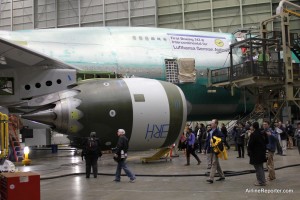
This is the first Boeing 747-8 Intercontinental that will carry paying passengers. The plane will be going to Lufthansa.
Tomorrow is the big day when Boeing will reveal their first Boeing 747-8 Intercontinental to the world. While we wait, some invited guests got an opportunity to tour the factory floor and the Boeing 747-8I\747-8F production line.
When first walking in, a Boeing 747-8F for Atlas Air was front and center. We were toured around to where the tail and horizontal stabilizers are made and where the wings start their lives. It was interesting going from one stop to the next seeing seeing all the individual parts, then getting to where they are start to put together to form a plane.
One of the biggest treats was getting an inside look at all three levels of the front of a Boeing 747-8 Intercontinental, which is still in pieces (photo of the upper deck). It was impressive seeing how long the inside of the upper deck will be — can’t wait to fly on it.
For now, I am just doing a quick post, since currently at the Boeing Customer Experience Center. More photos to come throughout the weekend.
CHECK OUT ALL 45 PHOTOS FROM TODAY’S BOEING FACTORY TOUR
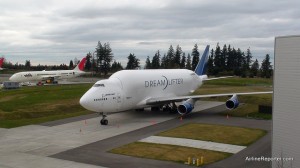
Come see a Dreamlifter up close at the Future of Flight.
With the unveiling of the Boeing 747-8 Intercontinental, some of your favorite aviation journalists are all in Seattle. What better time to have a little TweetUp? What the heck is a TweetUp you ask? It is an in-person meeting of like-minded people from Twitter getting together to hang out. This TweetUp still start at about 3pm and go for about an hour. Come say hello to cool folks like Jon Ostrower (Flight Blogger) and others. We will also get VIP access to take photos of the Dreamlifter parked next to the Future of Flight.
Although many of the media folks will be busy writing up stories and posting photos on the Boeing 747-8I earlier in the day on Sunday, if you want to arrive early to Paine Field, you can also check out the new MiG 29 that is housed at the Historic Flight. Unfortunately, all the other great aviation places at Paine Field will be closed on Sunday, but the Future of Flight and Historic Flight should keep you entertained enough.
No need to sign up, just show up in the Future of Flight lobby at 3pm (directions). Bring your camera and your mobile device to Tweet — see you there!
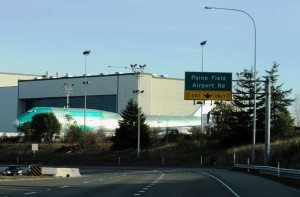
What a nice site to see while driving on the highway. Boeing's first 747-8 Intercontinental
This Sunday Boeing will unveil their newest and largest plane; the Boeing 747-8 Intercontinental. I have been asked by quite a few fans if the public will be able to see the airplane. The bad news is no, the whole unveiling will be done inside, meaning you can’t catch a glimpse from the Future of Flight or their parking lot — bummer.
However, the good news is Boeing will be doing a live feed of the event at Boeing’s NewAirplane.com site. The live webcast will start at 11am PST on Sunday the 13th. Boeing will be giving information to the media starting Saturday morning, so you will be able to catch a lot more via Twitter. You can follow me (@AirlineReporter), @FlightBlogger and/or the hashtag #7478FT.
I have been trying to find out what livery the 747-8I will have, but Boeing isn’t talking. Guess we will all have to find out on Sunday. I am hoping it is the full Boeing livery, but I think even the light livery should look slick. Who knows, maybe they will go a little crazy and it will be in Lufthansa livery. Either way, I can’t wait.
Image: moonm




